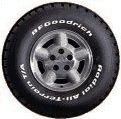

 Cars, bicycles, motor
cycles, aeroplanes, lorries, buses and agricultural equipment all use tyres made from rubber: bands or air-filled tubes
surrounding the wheel to strengthen it and absorb shock.
Cars, bicycles, motor
cycles, aeroplanes, lorries, buses and agricultural equipment all use tyres made from rubber: bands or air-filled tubes
surrounding the wheel to strengthen it and absorb shock.
The pneumatic tyre was invented in 1845 by a Scot, R.W. Thompson, for use on horse-drawn coaches. It was made from natural rubber, which is produced as latex by rubber trees. Most vehicle tyres today are made from a mixture of natural and synthetic rubber, the ratio of the mix depending on the end use. The properties of natural rubber include cut and tear resistance and good flexibility while synthetic rubber offers better grip on the road. As well as the rubber compound, additional raw materials for tyre production are steel wire and textiles, both used to strengthen the tyre.
There are thousands of different sizes and types of tyre on the market. Estimates suggest that around 1,000 million tyres are made each year, mainly in Korea, Japan and Canada.
 The life of a tyre depends not
just on the quality of the tyre itself but also on other factors including the distance
travelled, and the speed and manner of driving. However, technological improvements,
including the replacement of cross ply tubes with radial ply, have already doubled the
typical life of a car tyre in the past twenty years, to an average 48,000 kilometres.
The life of a tyre depends not
just on the quality of the tyre itself but also on other factors including the distance
travelled, and the speed and manner of driving. However, technological improvements,
including the replacement of cross ply tubes with radial ply, have already doubled the
typical life of a car tyre in the past twenty years, to an average 48,000 kilometres.
A typical European car tyre weighs 6.5-7.5 kg. By contrast, in the USA an average car tyre weighs 8-9 kg. The weight varies according to the number of factors including the size of the vehicle and the country's climate, speed limits and road structure. For example, in northern Europe extremely cold winters may require vehicles to have a second heavy duty set of winter tyres, sometimes fitted with chains, to deal with the road conditions. Also in the colder north people typically drive heavier cars which require heavier tyres, compared to lighter weight vehicles in southern countries whose tyre are both smaller and lighter. Often people living in the more densely populated areas may choose to drive smaller vehicles, for practical reasons of space and manoeuvrability. This, plus the shorter distances they may need to travel, has an impact on the size of tyres they buy, and the frequency with which they need to be changed.
Average mileage matters, because the higher the mileage driven the more frequently tyres need to be changed to comply with legal limits and to be safe. On average, an European car tyre's life is 35,000-45,000 km but this varies according to minimum tread standards in different countries.


These pages were last
updated on 25th July 1999.
Hits since 25th July 1999: